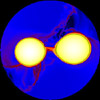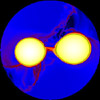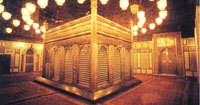
The Structure, Stability, and Dynamics of Self-Graviting Systems [Archives:2000/47/Science & Technology]
November 20 2000
Prof. Salem
Al-AbdelRahman
The purpose of Joel Tohlines on-line textbook, The Structure, Stability, and Dynamics of Self-Graviting Systems, is twofold. The textbook aims to document in an electronically accessible format many of the key physical principles that underlie modern discussions of the structure, stability, and dynamic evolution of astrophysical fluid systems. The second purpose is to take advantage of the added dimensions offered by the hypertext medium – particularly color, animation, and text linkage – to effectively illustrate many of these physical principles.
Tohline, professor of physics at Louisiana State University and a member of CIPs Advisory Committee, is a thorough believer in the superiority of hypertext and multimedia materials over conventional printed matter for teaching science and presenting scientific research. His textbook, which is currently under development, maybe found at http://www.phys.lsu.edu/astro/H_Book.current/H_Book.shtml.
According to Tohline, hypermedia documents are particularly valuable in presenting scientific results that involve visualization. It seems illogical to reduce a computer-generated animation sequence to a still image (or even a set of still images) for publication, when the animation itself could be distributed electronically over the Internet. Tohline cites his work on computational-fluid-dynamics (CFD) simulations using a heterogeneous computing environment as an instance in which hypermedia should be used to present a visualization that is an integral part of a simulation experiment. The heterogeneous environment couples a massively parallel Cray T3E super computer with an SGI workstation in order to animate the CFD results. Tohlines research group has developed an efficient CDF algorithm, but to make the results understandable, they must be visualized.
Accordingly, the Cray super computer pauses at intervals and dumps out a data set that the SGI renders as an image. This image is stored as on animation frame. Eight hours worth of commutation on the Cray yields around 30 frames of an animation that may eventually contain up to 2000 frames. The animation is produced as a natural by-product of the simulation.

With his online text-book, Tohline hopes to participate in and suggest the future directions of this process. A printed journal is just a small subset of the kind of information that most scientists would like to make available on a regular basis. Tohline says. We shouldnt abandon the printed page, but I believe that the printed page will be like a readers digest, with short excerpts of what is available on-line.
Visitors to Tohlines Web site will find animations in plenty, presented as Java applets, MPEG movies, VRML simulation, and visualizations of data generated by Mathematics. These animations are integrated into the presentation of the course material but are also offered to the visitor independently, with the invitation to Try a Java (or movie, VRML, or mathematical, or HSCF [hachisu Self-Consistent-Field Technique]) example! Tables show which sections of the textbook are accompanied by animations, which are not, and which areas of the text are still being written.
Tohline wrote some of the animation programs himself and has involved students in writing others. (Peter Nelson, an LSU undergraduate, has been instrumental in helping Tohline to manage the layout of the textbook at it has grown in size). Visitors to the site can also read brief explanations of the principal partial-differential equations that govern self-gravitating systems, with variables and constants in the equations hyperlinked to their definitions in a glossary. Students can test their understanding by doing sample problems and check their work by exploring the hyperlinked answers.
The open-endedness of hyper-media documents and the collaborative possibilities they invite are among their most important advantages of on-line publication for Tohline. In a recent semester he taught a course using the on-line text-book, in which he would assign students specific projects in areas not yet covered in the text. These projects involved designing small problems, writing chapters in HTML that presented the solutions, and putting the work on-line for viewing by other students. These assignments opened up the possibility of including the students chapters in the text and crediting the students for their work.
Likewise, according to Tohline, experts in particular fields could contribute hypertext chapters in what has the potential to become far more of a collaborative than an individual project. The ability to update hyper-media documents continually and convenient multi-author collaboration imply the possibility of creating a text-book that resists becoming obsolete.
Tohline hopes to be ready by the end of December to advertise his text-books existence to the astrophysics community, along with an invitation to others to participate in the books evolution.
The material is sufficiently complete that it could appear in a book, though it never will, Tohlin says. Virtually everyone who sees what I am doing asks when I will publish it [in print], but there are many features that would be lost if I did.
In Tohlines view, hypermedia and not print is the best form in which his work can appear: I strongly feel that this will be the medium of all scholarly publication, not just that aimed at students.
——
[archive-e:47-v:2000-y:2000-d:2000-11-20-p:./2000/iss47/techno.htm]


